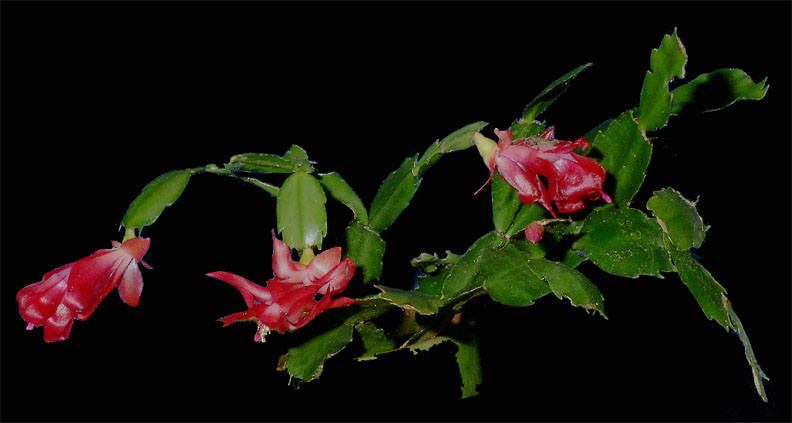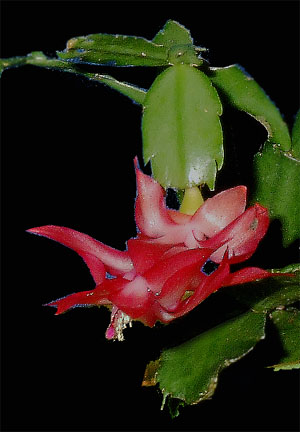![]()
Aroids and other genera in the Collection
Take the Tour Now?
Orchids
The
Exotic Rainforest
Schlumbergera
Lem., containing species formerly
the
genus Zygocactus (K. Schum.) Moran
The length of the day may
not be the only trigger that causes an inflorescence to form!

Schlumbergera
Lem., containing species formerly
the
genus Zygocactus (K. Schum.) Moran
Common Names: Christmas Cactus, Zygocactus, Holiday Cactus, Thanksgiving Cactus, Easter Cactus
Common Names: Christmas Cactus, Zygocactus, Holiday Cactus, Thanksgiving Cactus, Easter Cactus
Available in my hybrid variations
and colors
Commonly called Zygocactus, or more commonly Christmas Cactus, according to Willis’s Dictionary of Flowering plants Zygocactus are now correctly in the genus Schlumbergera Lem. There there are two to five found species only only in
The natural
species produce beautiful inflorescences (commonly called "flowers") which can range in color from pink to
red. An inflorescence is a group of "flowers". The color of the
"flower" is often influenced by artificial
hybridization due to selective breeding and not by the natural colors
found in the rain forest. Hybridized colors often include pink,
red, white, lavender, and purple although the natural color in nature
appears to be more consistently reddish pink. The blooming season and
length are likely to
depending on the care given the specimen. A specimen may grow to a
height of up to 45cm (1.5 feet).
 Although Zygocactus
appear to respond to shorter daylight durations that may not the total
cause. There may be additional reasons for the time they choose to
bloom since scientific observations indicate
some wild species do not bloom during the North American Thanksgiving or Christmas
season. A shortened daylight period may not be the only trigger
that causes blooming.
Although Zygocactus
appear to respond to shorter daylight durations that may not the total
cause. There may be additional reasons for the time they choose to
bloom since scientific observations indicate
some wild species do not bloom during the North American Thanksgiving or Christmas
season. A shortened daylight period may not be the only trigger
that causes blooming.
Although the daylight photo period is
not equarl in the region of Rio de Janeiro where these species are more
common, In the South American rain forest
both summer and winter days are relatively of equal length due to their position
much nearer the
equator than North America or Europe.
These cacti gain their common
name as a result of the season of the year in which they typically bloom
which is roughly
late November through December in the northern hemisphere. In
Brazil they bloom during the South American winter which corresponds
with North America's summer but there is no real difference in Brazil in
the length of a summer or a winter day.
Many rain forest species are induced
to bloom based on the amount
of water given the plant by Mother Nature since both the temperature and
the day's length changes less than does the natural rain cycles. Many inflorescence producing
species are triggered to bloom near the beginning of the rainy season
while others bloom near the end of the heavy rain. Since
Zygocactus at least appears to bloom at the end of the rainy season the trigger
may be also induced due to the amount of water rather than solely the amount of
light given the plant by Mother Nature.
Many successful growers have learned to duplicate
Nature's methods and water a specimen more heavily in fast draining soil
during the heat of the year but slowly begin to reduce the amount of the
water given as the annual bloom season approaches. In our atrium
we water quite heavily with an overhead misting system from May through
early October but by November drop the daily mist from 8 minutes every
other day to only 2 minutes three days per week. As a result many
of our specimens that naturally bloom at the end of the rainy season are
triggered to produce their inflorescences just as they would in nature.
In nature Schlumbergera are epiphytic and grow on the branches of trees in relatively bright light instead of in soil. Plants that grow upon other plant species are known scientifically as epiphytes (epi-FITES). Since they are rain forest specimens, Zygocactus species prefer moderately bright indirect light with warm temperatures. As a result of their native habitat, the ambient temperature should not drop below 12.8C (55F). A very lose soil that is kept evenly damp during the wet season of the year but drier as winter approaches are more likely to induce Schlumbergera subgenus Zygocactus to prosper and bloom. Since Schlumbergera normally do not grow in soil, use a cactus soil mix or a soil mixture of fast draining potting media such as Miracle Grow Moisture Control which includes an equal amount of sand. Add to that mix a large helping of Perlite™, some peat moss, a bag of aquarium charcoal and orchid potting media which includes bark, gravel, and charcoal.
You can mix your own or begin with a "jungle mix" and add additional
orchid potting media. Your goal is to give the roots something to which they can cling as they
do in nature while remaining only damp and never soggy.